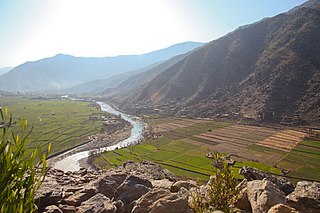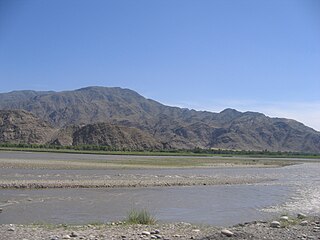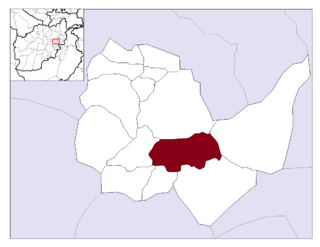
Gul Agha Sherzai, also known as Mohammad Shafiq, is a politician in Afghanistan. He is the former governor of Nangarhar province in eastern Afghanistan. He previously served as Governor of Kandahar province, in the early 1990s and from 2001 until 2003. In October 2013, Sherzai resigned from his post as governor and formally announced himself as a candidate for Afghanistan's 2014 Presidential Election, and served as the minister of border and tribal affairs until the Taliban victory in 2021.

Logar is one of the 34 provinces of Afghanistan located in the eastern section of the country. It is divided into 7 districts and contains hundreds of villages. Puli Alam is the capital of the province. As of 2021, Logar has a population of approximately 442,037 people, most of whom are ethnic Pashtuns and Tajiks.

Nangarhār also called Nangrahar or Ningrahar, is one of the 34 provinces of Afghanistan, located in the eastern part of the country and bordering Logar, Kabul, Laghman and Kunar provinces as well as having an international border with Pakistan. It is divided into 22 districts and has a population of about 1,735,531, the third highest of the country's 34 provinces. The city of Jalalabad is the capital of Nangarhar province. Nangarhar province is famous for fish and karaye, and the popular tourist locations Daroonta and Pul-e- Sayad.

The Shinwari is an ethnic Pashtun tribe of Afghanistan. Among the greatest poets of the Pashto language in the 20th century was the late Ameer Hamza Shinwari, also known as "Hamza Baba".
The Kharoti (Pashto:خروٹی) خروټی) are a Pashtun tribe of Ghilji origin, originating in the central part of Paktika Province, Afghanistan, but can be also found in other parts of the country. The Kharoti settled in Kharotabad in Quetta, British India around 1945.

Kunar is one of the 34 provinces of Afghanistan, located in the northeastern part of the country. Its capital is Asadabad. Its population is estimated to be 508,224. Kunar's major political groups include Wahhabis or Ahl-e- Hadith, Nazhat-e Hambastagi Milli, Hezb-e Afghanistan Naween, Hezb-e Islami Gulbuddin.

Mohammad Yunus Khalis was a mujahideen commander in Afghanistan during the Soviet–Afghan War. His party was called Hezb-i-Islami, the same as Gulbuddin Hekmatyar's party. The two are commonly differentiated as Hezb-e Islami Khalis and Hezb-e-Islami Gulbuddin.

Haji Abdul Qadeer was a prominent Northern Alliance leader in Afghanistan and opposed the Taliban. Originally a commander of the Hezb-i Islami Khalis faction during the Soviet–Afghan War, he then served as governor of Nangarhar Province, the head of the Eastern Afghanistan Shura, and later Vice President of Afghanistan and Minister of Public Works in the administration of Hamid Karzai from 19 June 2002 until his assassination on 6 July 2002. He was the older brother of fellow anti-Soviet and Northern Alliance commander Abdul Haq, who was executed in late 2001 by the Taliban.
Hajji Mohammed Zaman was a Pashtun Afghan military leader and politician. He was an ethnic Pashtun, connected to the Khogyani tribe. According to Maj. Dalton Fury, who fought together with Ghamsharik in November/December 2001 in the Tora Bora campaign against the Taliban, Haji Zaman had been "one of the more infamous mujahideen junior commanders during the Soviet–Afghan War. When the Taliban took over, Zaman departed Afghanistan for France. When the Taliban fell from grace after 9/11, he returned to his homeland to reclaim his former VIP status. He was said to have influential friends within neighboring Pakistan, including members of the Pakistan intelligence service. He reportedly led a force of 4,000 men during the campaign to oust Afghanistan's Soviet occupiers.

Abdul Haq was an Afghan mujahideen commander who fought against the Soviet-backed People's Democratic Party of Afghanistan, the de facto Afghan government in the 1980s. He was killed by the Taliban in October 2001 while trying to create a popular uprising against the Taliban in Afghanistan in the wake of the September 11th attacks.

Goshta District is located in the northeast of Nangarhar Province, Afghanistan and borders Durand Line between Afghanistan and Pakistan. The district's population is Pashtun and was estimated at 160,000 in 2002, of whom 30,000 were children under 12. The district is within the heartland of the Mohmand tribe of Pashtuns. The district centre is the village of Goshta, on the Kabul River.

Khogyani is a district in the south of Nangarhar Province, Afghanistan, bordering on Pakistan. Its population is entirely Pashtun, and was estimated at 146,852 in 2002. The district is within the heartland of the Khogyani tribe of Pashtuns. The district centre is the village of Kaga. District Governor Office, District Court, District Hospital, and other government agencies hold their office in Kaga. Kaga is the economic center of the district; however Wazir is the second largest market place. Recently, Kaga town has been connected with Jalalabad City through paved road. Wazir is also connected through a paved road with Kaga.

Kuz Kunar or Khewa is a district in the north of Nangarhar Province, Afghanistan, on the Kunar River. It is counted one of the more secure districts of Nangarhar, where many foreigners go to visit the social, agricultural and structural rehabilitation of the area. Its population, which is 75% Pashtun, was estimated at 167,640 in 2002, of whom 32,000 were children under 12.

Pachir Aw Agam, or Pachir Wa Agam, is a district in the southeast of Nangarhar Province, Afghanistan, bordering Pakistan. Its population, which is 100% Pashtun, was estimated at 39,280 in 2002, of whom 15,700 were children under 12. The district is within the heartland of the Khogyani tribe of Pashtuns. The district centre is the village of Pachir Aw Agam.
Hajji Din Mohammad also known as Azizullah Din Mohammad is a politician in Afghanistan who served as the Governor of Nangarhar Province followed by Governor of Kabul Province. He is currently the Chairman of Peace and Development Islamic Party. He has been involved in the peace and reconciliation process between the Afghan Government and the Taliban and is currently the deputy of High Council for National Reconciliation. Haji Din Mohammad comes from a distinguished Pashtun family "Arsala" The Arsala family is part of the Jabar Khel. He is also the elder brother of late Hajji Abdul Qadir and Abdul Haq His great-grandfather, Wazir Arsala Khan, served as Foreign Minister of Afghanistan in 1869. One of Arsala Khan's descendants, Taj Mohammad Khan, was a general at the Battle of Maiwand. Another descendant, Abdul Jabbar Khan, was Afghanistan’s first Ambassador to Russia.

Bagrami District is located in the central part of Kabul Province in Afghanistan. It is approximately a 30-minute drive east from the capital city, Kabul. The district headquarters is the town of Bagrami.

The Mullagori or Mulagori or Malagori is a Pashtun tribe present in Khyber District, tribal areas in Khyber Pakhtunkhwa, Pakistan. Historically, they are one of the smallest tribes of ethnic Pashtuns. They are considered as a sub-tribe of Momand Pashtun Ghoryakhel confederacy.

The Khugyani, Khogyani or Khogiani tribe is one of the Karlāṇī tribes of the Pashtun people. The tribe originated in the Khogyani district in Nangarhar province of Afghanistan. The Khogyani District is in eastern Nangarhar province of Afghanistan, near the city of Jalalabad and the Kōh-i-Safēd.
On January 15, 2010, the Department of Defense complied with a court order and published a list of Detainees held in the Bagram Theater Internment Facility that included the name Hajji Raiz.

The National Front of Afghanistan, or Jabh-e Melli, was established in late 2011 by Ahmad Zia Massoud, Haji Mohammad Mohaqiq and Abdul Rashid Dostum. It was generally regarded as a reformation of parts of the military wing which once existed of the United Front which with U.S. air support removed the Taliban from power in Afghanistan in late 2001. The National Front strongly opposed a return of the Taliban to power but failed to keep them in check. It retains only a small military apparatus today. The chairman of the National Front is Ahmad Zia Massoud, the younger brother of the Northern Alliance leader Ahmad Shah Massoud who was assassinated two days before the September 11 attacks in 2001. It is unclear if it is still in operation, as Afghanistan's Republican government has collapsed.















